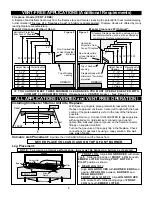
ALL APPLICATIONS (VENTED and VENT FREE OPERATION)
Ultrasonic Remote Control (Manual or Remote ON-OFF)
Before you start: Both the transmitter and receiver require 9 volt
batteries to operate in remote control.
The blue and black receiver wire leads are for the optional sound producing
device (CRACKLER Model CF5).
The receiver must be protected from overheating. Locate receiver well
away from heat. Accessory REMOTE LOG HOUSE (Model "RH") is
available for use as a heat resistant "log" in which the receiver portion of a
Wireless remote option may be located.
Operation Tips: This is a sound operated remote (unlike TV remotes which
SWITCH OFF REMOTE
ON ACCESS
ON
When switching
from REMOTE to
OFF, first turn set
off using the
transmitter.
Remote: Switch to
REMOTE ACCESS
ON. Aim, press button
and hold transmitter at
receiver.
Manual: Switch from
OFF to SWITCH ON;
SWITCH ON to OFF
are Infrared and operate instantly) and requires you to aim and hold the transmitter for 1 to 3 seconds to
operate. Manual Operation: (Receiver switch position ON or OFF) does not require batteries.
Remote Operation: Requires good batteries. If you turn the gas log on using the remote control and then turn
the set off by sliding the receiver switch from REMOTE to OFF, when you replace the switch to REMOTE it will
remain in the last selected remote position (in this case ON) and turn the gas log on.
To shutdown overnight or for any prolonged period, slide receiver switch to "OFF".
C7-R or DFC7-R (Remote Control) LIGHTING and OPERATION
Pilot Lighting (Remote Operated Valve):
N O T E : The Operating Dial has complete control of gas to
pilot and burner. The Operating Dial cannot be turned to
"OFF" without first depressing dial in "PILOT" position and
then rotating clockwise to "OFF". (see Figure 9)
1.
Depress and turn Operating Dial to "OFF" position. (Fig 9)
2.
Wait at least 5 minutes to allow gas which may have
accumulated around burner to escape.
3.
Turn Operating Dial to "PILOT" position.
Pilot Set Screw under plate here.
Operating Dial
Gas Dial
Figure 9
.
.
.
4.
Depress and hold until air is bled and gas flows to pilot.
5.
Light pilot. Continue to depress and hold in Operating Dial. Ignite pilot by cycling Operating Dial from
PILOT to IGN. Once pilot lights, continue to hold in Operating Dial until the Pilot flame remains lit when
knob is released (approximately 60 to 90 seconds). If Pilot does not remain lit, repeat steps 1 through 5 and
allow more time after Pilot Lighting before releasing knob. (Figure 9)
6.
Turn Operating Dial to "ON".
Ignition Interlock. The Ignition Interlock device prevents the re-establishment of gas flow following a loss of
pilot flame (Approximately five minutes). Releasing the Operating Dial prior to establishing a pilot may
engage the Ignition Interlock requiring approximately 5 minutes before you can attempt to re-light the pilot.
Burner ON or OFF and Adjustment (Remote Operated Valve): With the Operating Dial (Figure 9) in
the "ON" position, depress the "UP" or "DOWN" button on the transmitter to turn on/off and adjust flame height.
Complete Shutdown (Including Pilot): Depress "DOWN" button on transmitter until flame is completely out.
Slightly push and turn Operating Dial to "OFF". (Figure 6)
Pilot Location:
Pilot is located on right side behind front burner.
OP AMERICA Standard (Remote Models)
The Pilot flame should be steady and soft blue surrounding 1/8
inch of the thermocouple tip as shown in Figure 10.
OP AMERICA Millivolt (Switch Model)
NOTE: The OP America Millivolt Pilot/ODS is equipped with a quick
acting thermocouple allowing gas flow to the pilot after
approximately 30-40 seconds. An additional 60 to 90 seconds time
is required to fully heat the thermogenerator and allow gas to the
main burner(s).
Pilot Flame Adjustment. Pilot flame should be steady and soft
THERMOGENERATOR (Switch Models)
LP THEMOCOUPLE
NAT GAS
THERMOCOUPLE
PIEZO SPARKER
PILOT FLAME
Figure 10
AIR INTAKE
HOLES
blue extending approx. 1 inch beyond the pilot tube. If adjustment is necessary, use a narrow long stem screw driver
to turn pilot adjustment screw (see Figure 8-Switch or Figure 9-Remote). To adjust turn clockwise for less pilot flame,
counterclockwise for more pilot flame. There is no pilot adjustment available on C7 or DFC7 Manual Models.
IMPORTANT SERVICE TIP! Obstructed Pilot Air Intake Ports result in an improper gas/air mixture
and a weak pilot flame. Weak pilot flame is the NUMBER 1 SERVICE ISSUE RE NUISANCE
SHUT-OFF. Using canned compressed air , pipe cleaner or an artist's brush, clean out the opposing
Air Intake Ports located at base of Pilot (where gas supply line attaches to pilot). (Figure 10)
.
9































